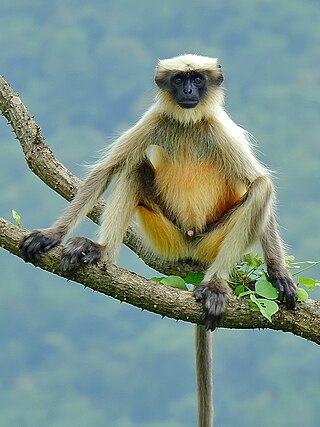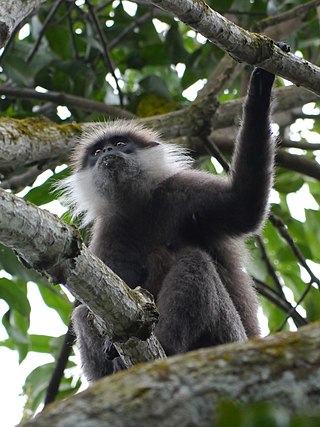
Gray langurs, also called Hanuman langurs and Hanuman monkeys, are Old World monkeys native to the Indian subcontinent constituting the genus Semnopithecus. Traditionally only one species Semnopithecus entellus was recognized, but since about 2001, additional species have been recognized. The taxonomy has been in flux, but currently eight species are recognized.

The surilis are a group of Old World monkeys in the genus Presbytis. They live in the Thai-Malay Peninsula, on Sumatra, Borneo, Java and smaller nearby islands. Besides surili, the common names for the monkeys in the genus also often use the terms "langur" or "leaf monkey."

Gee's golden langur, also known as simply the golden langur, is an Old World monkey found in a small region of Western Assam, India and in the neighboring foothills of the Black Mountains of Bhutan. Long considered sacred by many Himalayan people, the golden langur was first brought to the attention of the Western world by the naturalist Edward Pritchard Gee in the 1950s. Adult males have a cream to golden coat with darker flanks while the females and juveniles are lighter. It has a black face and a long tail up to 50 cm (19.69 in) in length. It lives in high trees and has a herbivorous diet of fruits, leaves, seeds, buds and flowers. The average group size is eight individuals, with a ratio of several females to each adult male. It is one of the most endangered primate species of India and Bhutan.

The silvery lutung, also known as the silvered leaf monkey or the silvery langur, is an Old World monkey. It is arboreal, living in coastal, mangrove, and riverine forests in Peninsular Malaysia, Sumatra, and Borneo.

Hose's palm civet, also known as Hose's civet, is a viverrid species endemic to the island of Borneo. It is listed on the IUCN Red List as Vulnerable because of an ongoing population decline, estimated to be more than 30% over the last three generations and suspected to be more than 30% in the next three generations due to declines in population inferred from habitat destruction and degradation.

Phayre's leaf monkey, also known as Phayre's langur, is a species of lutung native to South and Southeast Asia, namely India, Bangladesh, and Myanmar. Populations from further east are now thought to belong to other species. It is listed as Endangered on the IUCN Red List and is threatened by hunting and loss of habitat. The species epithet commemorates Arthur Purves Phayre.

The Javan surili is a vulnerable species of Old World monkey endemic to the western half of Java, Indonesia, a biodiversity hotspot. Other common names by which it is known by include gray, grizzled or Sunda Island surili; grizzled or stripe-crested langur; Javan grizzled langur; grizzled, Java or Javan leaf monkey; langur gris.

The Raffles' banded langur, also known as the banded leaf monkey or banded surili, is a species of primate in the family Cercopithecidae. It is endemic to Singapore and southern Peninsular Malaysia. The species underwent taxonomic revisions in 2019 and 2020, in which two former subspecies were elevated to separate species. As a result, the Raffles' banded langur meets the criteria for being listed as critically endangered by the IUCN. It is mainly threatened by habitat loss.

Hose's langur is a species of primate in the family Cercopithecidae endemic to the island of Borneo, including Brunei, Kalimantan (Indonesia), and East Malaysia. Its natural habitat is subtropical or tropical dry forests. It is threatened by habitat loss. It was first identified in Kutai National Park and Sangkulirang Peninsula, East Kalimantan, Indonesia, in 1985.

The Mentawai langur is a species of primate in the family Cercopithecidae. It is endemic to the Mentawai Islands in Indonesia. Its natural habitat is subtropical or tropical dry forests. The Siberut langur was formerly considered a subspecies of the Mentawai langur.

The northern plains gray langur, also known as the sacred langur, Bengal sacred langur and Hanuman langur, is a species of primate in the family Cercopithecidae.

The western purple-faced langur, also known as the north lowland wetzone purple-faced langur, is a subspecies of purple-faced langur endemic to Sri Lanka. It lives in the wet zone in western Sri Lanka around the former capital city of Colombo. This subspecies are known to live in tropical rainforest, specifically in an area of Sri Lanka, where it is noted to rain two times more compared to the neighboring region. The subspecies is generally gray-brown with lighter whiskers, a gray rump patch, and dark forearms and legs. These monkeys also have dark brown or black, hairless faces. Their hands and feet are also hairless. When infants, their fur is medium brown to light gray, however it changes to their darker adult colors at between 12 and 16 weeks old. Typical length is between 48 and 67 centimetres excluding tail, with a 59 to 85 centimetres tail. On average, males weigh 8.5 kilograms (19 lb) and females weigh 7.8 kilograms (17 lb). Their average life span is about 26 years if the monkey was held in captivity. Due to their leafy diet, the western purple-faced langur back teeth, include high crowns and pointed cusps to make eating through greenery simpler. They also developed a digestive system that would allow them to break down cellulose in the leaves they eat. Although, leaves are their primary source of food, they also eat fruits and flowers. Female langurs hold a pregnancy for 195-210 days, and after the birth the offsprings are taken closely cared for by the mother until they are about 12-20 weeks old.

The Selangor silvered langur is a species of leaf monkey found on the west coast of Peninsular Malaysia. It had been previously considered a form of silvery lutung. Roos and colleagues elevated this population to a subspecies level, Trachypithecus cristatus selangorensis, in 2008. It has since come to be regarded by primatologists as a separate species, Trachypithecus selangorensis.
The East Sumatran banded langur, also known as the East Sumatran banded surili, is a species of monkey in the family Cercopithecidae. It was formerly considered a subspecies of the Raffles' banded langur Presbytis femoralis, but genetic analysis revealed it to be a separate species. Its range is restricted to the Riau Province of east-central Sumatra. Due to its declining population and restricted range in small, isolated forests subject to high rates of deforestation, the IUCN declared it to be a critically endangered species in 2020.
The mitered langur is a species of monkey in the family Cercopithecidae. It was formerly considered a subspecies of the Sumatran surili, Presbytis melalophos but genetic analysis revealed that these are separate species. The mitered langur is native to the island of Sumatra in Indonesia. It is listed as endangered by the IUCN due primarily to deforestation, and also due to animals taken for pets.
The black-and-white langur is a species of monkey in the family Cercopithecidae. It was formerly considered a subspecies of the Black-crested Sumatran langur, Presbytis melalophos but genetic analysis revealed that these are separate species.
The black Sumatran langur is a species of monkey in the family Cercopithecidae. It was formerly considered a subspecies of the Sumatran surili, Presbytis melalophos but genetic analysis revealed that these are separate species. The black Sumatran langur is native to the island of Sumatra in Indonesia. It is listed as endangered by the IUCN due primarily to deforestation, and also due to animals taken for pets.

The Siberut langur is a species of monkey in the family Cercopithecidae. It was formerly considered a subspecies of the Mentawai langur, Presbytis potenziani but genetic analysis revealed that these are separate species. The Siberut langur is native to the island of Siberut in Indonesia. It is listed as endangered by the IUCN.

Miller's langur, also known as Miller's grizzled langur or Kutai grey langur, is a species of leaf monkey. It is endemic to East Kalimantan on the island of Borneo in Indonesia. It is one of the world's most endangered primates, and was at one time thought to be extinct, until it was rediscovered in 2012.















